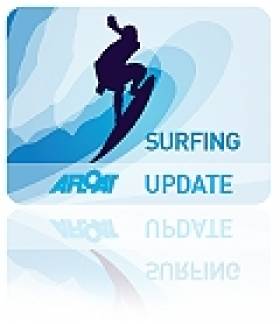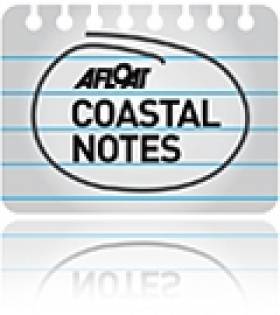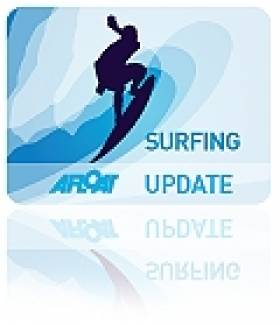Displaying items by tag: Irish Surfing Association
Surfers Speak Out Over Doolin Point
Local surfers have expressed their dismay over the decision by Clare County Council to approve the new pier development at Doolin Point.
The Irish Surfing Association (ISA) maintains that even the revised plan - accepted by the council's 32 members following previous objections - would result in the destruction of the renowned waves at Doolin Point and Crab Island.
"I am very disappointed with this decision," Neil Cooney of West Coast Surf Club told Surfer Today. "A great deal of work was put into the West Coast Surf Club and ISA submission but it seems that the issues raised were ignored and brushed over."
He added: "If this development is built as now proposed it would be a catastrophe."
Clare County Council Approves Doolin Development
The controversial €6 million deveopment of Doolin Point has been backed unanimously by Clare councillors.
Clare county manager Tom Coughlan had recommended giving approval for the revised plan, which was submitted after surfers expressed concerns over the impact of the original scheme on waves in the area.
The scheme has already received support from the Doolin Coast Guard Unit and local tourism and business groups.
But according to The Irish Times, the Irish Surfing Association (ISA) maintains that even the amended plans – which move the new pier 25m further away from the surf – would destroy the "world renowned" Crab Island and Doolin Point waves.
The ISA and West Coast Surf Club have warned the council that loss of the waves could cost up to €33 million per year in revenue generated by surf tourism in the area - a concern backed by Fáilte Ireland.
The Doolin Point pier project must be completed by the end of this year in order for the council to draw the €6 million in Government funding required.
Surf Calendar Kicks Off With Intervarsities
The Irish surfing calendar begins on 19 February with the 2011 Irish Surf Intervarsities at East Strand in Portrush, Co Antrim.
The weekend will feature contests in men's and women's surfing, bodyboarding and longboarding, as well as a novice surfing category open to students who have been surfing for less than a year.
The competition will be hosted by the Irish Surfing Association, the Causeway Coast Surf Club and Coleraine University Surf Club.
Registration is open from 5pm-9pm on Friday 18 February for any students hoping to take part. The Irish Surfing Association website has more information HERE.
Irish Surfing Calendar of Events for 2011
The Irish Surfing Association has released its draft calendar of events for the 2011 season.
Beginning in late February with the Irish Student Nationals in Portrush, the season takes in 16 weekends of meets - including the World Junior Surfing Championships in Peru and the week-long Eurosurf 2011 in Bundoran - and concludes with the Rossnowlagh Intercounties on 15-16 October.
Calendar of Events 2011:
19-20 February: Irish Student Nationals, Portrush, Co Antrim
4 March: ISA Executive Meeting, Lahinch, Co Clare
5-6 March: CSkins Junior Championship, Lahinch, Co Clare, Junior Tour Event 1
19-20 March: Tramore Junior & Senior Championships, Senior Tour Event 1/Junior Tour Event 2
26-27 March: Bundoran Senior Championships, Senior Tour Event 2
9-10 April: Portrush Senior Championships, Senior Tour Event 3
21-29 May: World Junior Surfing Championships, Peru
17-18 April: WCSC Kennys Open, Lahinch, Co Clare
11 June: ISA Executive Meeting, Dublin
4-5 June: WCSC Cold Pro, Spanish Point, Co Clare
25-26 June: Junior Tour Event 3
18-19 June: Rossnowlagh Longboard Championships, Rossnowlagh, Co Donegal
30-31 July: Co Sligo Open, Senior Tour Event 4
20-21 August: Rossnowlagh Junior Championships, Junior Tour Event 4
2 September: ISA Executive Meeting, Bundoran, Co Donegal
3-4 September: Bundoran Board Riders Junior Club Championships, Bundoran, Co Donegal
10-11 September: WCSC Longboard Contest
23 September-2 October: Eurosurf 2011, Bundoran, Co Donegal
15-16 October: Rossnowlagh Intercounties
7 December: ISA Executive Meeting, Athlone
Surf Safely This Winter
The Irish Surfing Association (ISA) has posted a useful guide for surfing safely over the winter months.
Caution is recommended for surfers at this time of year due to the colder water temperatures combined with stronger swells, severe winds and treacherous currents.
The ISA advises surfers to "leave the 'gung-ho' attitude at home and make safety your priority".
Among the many common-sense tips, it's also advisable to warm your body before and after surfing – warm drinks such as tea or hot chocolate are just the thing for this.
































































